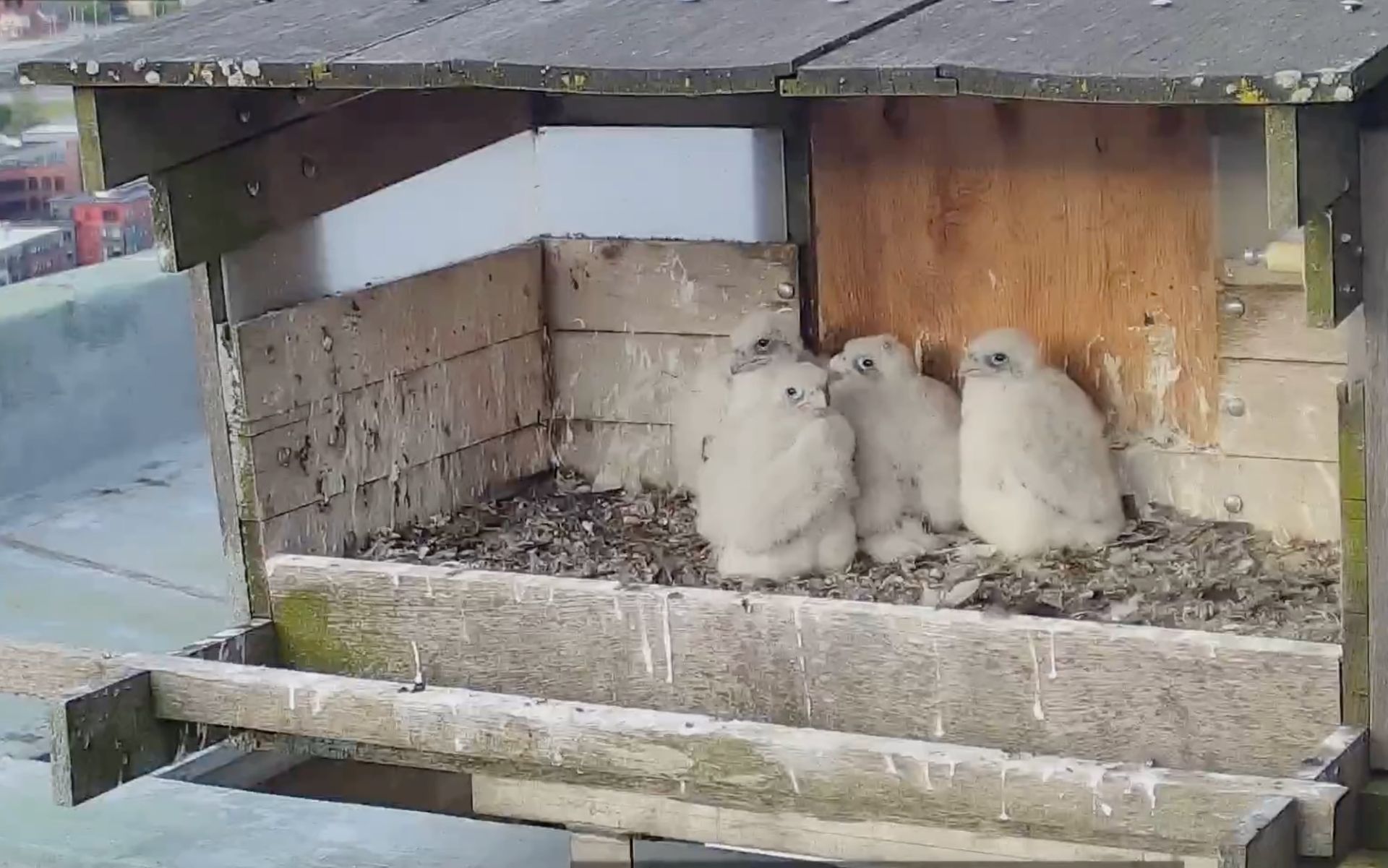Peregrine Falcon
The crow-sized Peregrine Falcon is the largest of three falcons recorded at Salter Grove, and has proven to be just as rare as the American Kestrel and the Merlin. From 2002 through 2022, it has only been reported three times, in October 2014, January 2021, and October 2022. Likely vantage points within the park include Audubon Field, the Parking Lot, and the causeway, where wide views of the landscape are possible.
It is the fastest animal in the world, speeding up to 70 miles per hour in pursuit of prey. It reaches over 240 mph as it dives towards its prey from over half a mile above. As it nears the target, it does an abrupt bottom turn that generates 10 to 25 G (10-25 times force of gravity), a force that would knock a human unconscious! There are special structures in its eyes, and nose to make such a high-pressure hunting style bearable.
The Peregrin Falcon feeds most often on medium-sized birds like doves, pigeons, shorebirds, and waterfowl. As many as 450 species of North American birds have been listed as its prey. They range from the tiny hummingbird (0.1 oz) to the sizable Sandhill Crane (109 oz or 6.8 lb.), including even raptors such as owls, hawks, and falcons. Bats and other small mammals are consumed as well.
Besides being the fastest bird, the Peregrine is also the most cosmopolitan. With the exception of New Zealand and Antartica, it occurs on all the land masses of the world. In the Americas, it breeds from the Arctic tundra to the tropics, avoiding only the extreme polar regions, very high mountain, and rainforests. The northernmost populations in North America migrate to winter in South America. Populations that breed in regions with more moderate winters tend to be permanent residents.
Male and female Peregrine Falcons have the same plumage but females can be up to 50% larger than their mate. In the wild, pairs set up housekeeping on ledges of tall cliffs within expansive habitats such as mountain ranges, coastlines, grasslands, and meadows. Within recent decades, breeding pairs have colonized large cities across North America. They return year after year to nest on skyscrapers and bridges and feed their young with abundant urban birds such as House Sparrows, European Starlings, and especially, Rock Pigeons.
In 2010, the Audubon Society of Rhode Island started live-streaming the day-to-day activities of a breeding pair on top of the "Superman Building" at 111 Westminster Street in Providence (see link below). Since then, birdwatchers in Massachusetts, New Jersey, and New York have reported sightings of adults that were banded as nestlings at this landmark building.
The Peregrine Falcon was quite endangered between the 1940's and 1970's because they were consuming prey that contained high levels of DDT. This pesticide was widely used because it was extremely effective in controlling insect-borne diseases like malaria and typhus. However, its harmful trickle-up effects on the reproductive metabolism of top-of the-food chain predators were not understood until nearly too late.
Many other raptors, including the Bald Eagle were in rapid decline because DDT prevented proper eggshell formation, which meant that few eggs survived to hatchling stage. The Peregrine Falcon was gone from New England by the 1960's. Raptor populations rebounded overall in North America after DDT was banned in 1972 and captive breeding and release programs reinstated missing species and augmented numbers.
Because of its even temperament and eagerness to hunt, the Peregrine Falcon has been a favorite of falconers for over 3,000 years. Trained Peregrine Falcons have been used to scare away flocking birds at airports to reduce bird-plane collisions. They were even used to intercept homing pigeons during World War II to gain intelligence of enemy tactics and troop movements.
For more information:
https://www.allaboutbirds.org/guide/Peregrine_Falcon
https://www.audubon.org/field-guide/bird/peregrine-falcon
https://en.wikipedia.org/wiki/Peregrine_falcon
http://www.biokids.umich.edu/critters/Falco_peregrinus/
https://centerofthewest.org/2013/10/25/my-favorite-interesting-facts-about-peregrine-falcons/
https://asri.org/view/peregrine-cam.html Providence Peregrine Webcam
https://www.youtube.com/watch?v=ovocT91G1ww&t=6s Smithsonian Channel video
https://providenceraptors.com/
Green, P. (2020). Providence Raptors: Documenting the Lives of Urban Birds of Prey. Providenceraptors.com.













, female (R, 63-AE) 00may15.jpeg?w=350?blur=10)


